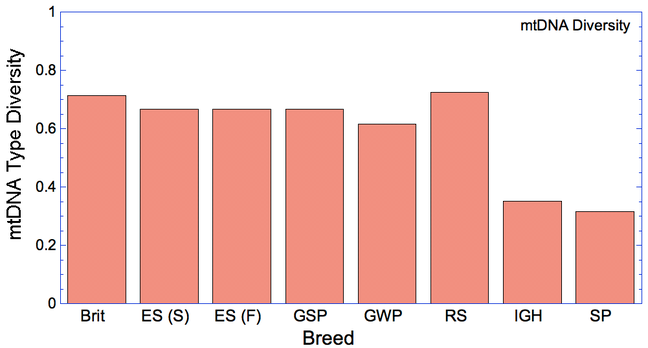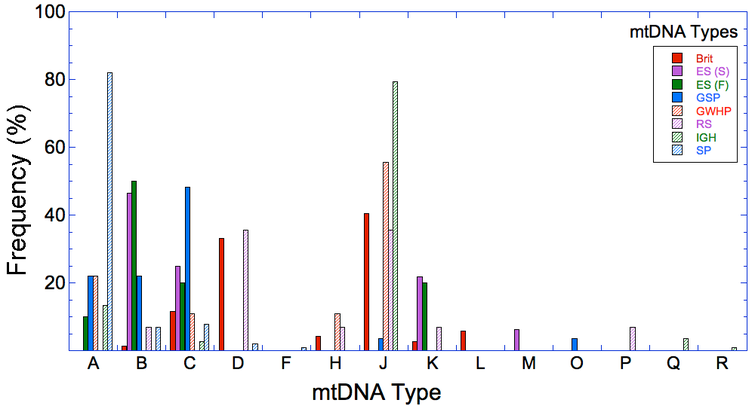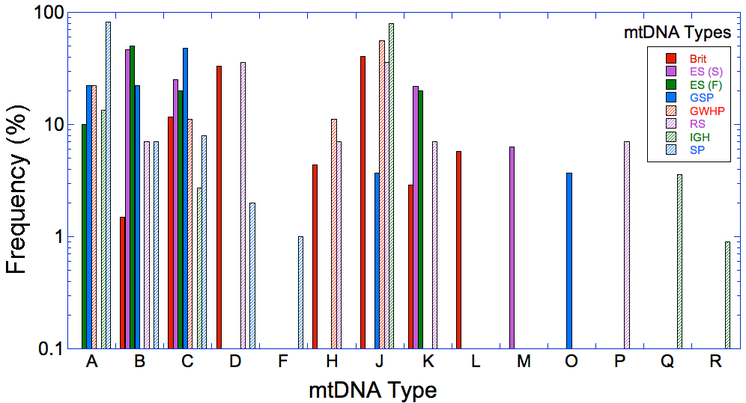mtDNA Types
Data from
- Pedersen N, H Liu, G Theilen & B Sacks. 2012. The effects of dog breed development on genetic diversity and the relative influence of performance and conformation breeding. J Anim Breed Genet 2012: 1-13.
Mitochondrial DNA types (mtDNA) types by breed: Brittany (Brit); English Setter (show); English Setter (field); German Shorthaired Pointer (GSP); German Wirehaired Pointer (GWP); Red Setter (RS); Italian Greyhound (IGH); Standard Poodle (SP). Haplotype equivalents of those listed here are reported in Pedersen et al (2012) and listed below (*).
Frequencies of mitochondrial DNA types by breed. The top graph is on a linear y axis; below the y axis is logged to visualize the types at very low frequency.
The Brittany and Red Setter have the broadest representation of mtDNA types (7 and 6, respectively). Breeds with only 4 types represented are English Setter (both types), German Wirehaired Pointer, Italian Greyhound, and Standard Poodle, and in the latter two more than 75% of dogs had a single type (J in Italian Greyhounds and A in Standard Poodles).
The Red Setter and Brittany have the greatest diversity in mtDNA types. The Italian Greyhound and Standard Poodle are both very low.
Breed frequencies of mitochondrial DNA types by type designation (letters; haplotypes listed at the bottom *); above on linear y axis, below on log y axis.
Seven types were found in only a single breed (F, L, M, O, P, Q, and R), and A, B, and C were most widely distributed.
Seven types were found in only a single breed (F, L, M, O, P, Q, and R), and A, B, and C were most widely distributed.
* Equivalent haplotypes for mtDNA types:
A = B1, B2, B3, B5, B6, B13
B = A18, A20
C = A11, A13
D = A24, A25
F = D5
H = A1, A2
J = A16, A17, A33
K = C3
L = "1 nt different C3"
M = "1 not different A11, A13"
O = A3, A5, A7, A8, A9
P = "1 not different A11, A13"
Q = B11
R = C1, C2
A = B1, B2, B3, B5, B6, B13
B = A18, A20
C = A11, A13
D = A24, A25
F = D5
H = A1, A2
J = A16, A17, A33
K = C3
L = "1 nt different C3"
M = "1 not different A11, A13"
O = A3, A5, A7, A8, A9
P = "1 not different A11, A13"
Q = B11
R = C1, C2






